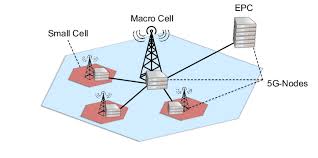

5g small and macro cells
The big change implemented in 5g is (will be) mmWave, transmission frequency at 26GHz. These waves have a large capacity but have two distinct disadvantages :
- They do not go through windows, walls etc and on a day with poor atmospheric conditions (rain) they do not go through damp air nor rain.
- They do not have a long range before the signal is dissipated.
The other two frequencies, 700MHz and 3.4GHz leads to macro cells as in 4G, slightly smaller cells with 3.4GHz than with 700MHz. These macro cells will provide applications using mobile broadband, i.e. applications similar in nature to those in place for 4G.
These macro cells will have to be used for autonomous vehicle applications, the handover between small cells likely to be too restricting on such applications
In 4G, the handover is between adjoining cells, where the signal from one cell decreases and that from a second increases up to the point the handover must take place in order for the user device to continue working. Handover in 5G from a small cell to a macrocell also needs to be managed within 5G for mobile or moving devices. We need small cell to small cell handover, which would maintain the application and also small cell to macro cell (or the reverse) where the operation of the application could be affected.
© mobilephonetechnology.co.uk all rights reserved 2017-2025
